There are things that every popular commercial open-source software company has in common.
Rock-solid products. Developer goodwill. And the challenge of monetization.
Developers are a hard bunch to sell to. Their preferred watering holes are more dark funnel than top-of-funnel and they’re famously sales-averse. Which puts COSS companies in a pickle.
How do you turn open-source affinity into annual recurring revenue without alienating your audience or evaporating trust? The good news is, it’s not only possible—it’s scalable.
Here’s how organizations like Temporal, Apollo GraphQL, and Pulumi fuel revenue growth with open-source signals using Common Room.
Light up the dark funnel
Problem
Visibility into dev-centric channels—like GitHub, X (Twitter), Discord, DEV, Stack Overflow, and others—is murky at best.
Tracking activity in a timely manner is difficult. And identifying the people and companies behind the usernames—let alone connecting the dots between their activities across channels—is next to impossible.
Solution
Our customers use digital signal capture to uncover, unify, and analyze cross-channel activity all in one place. No tab hopping necessary.
Activities from every connected data source—from GitHub repo stars to X mentions to Discord discussions—are automatically pulled into Common Room.
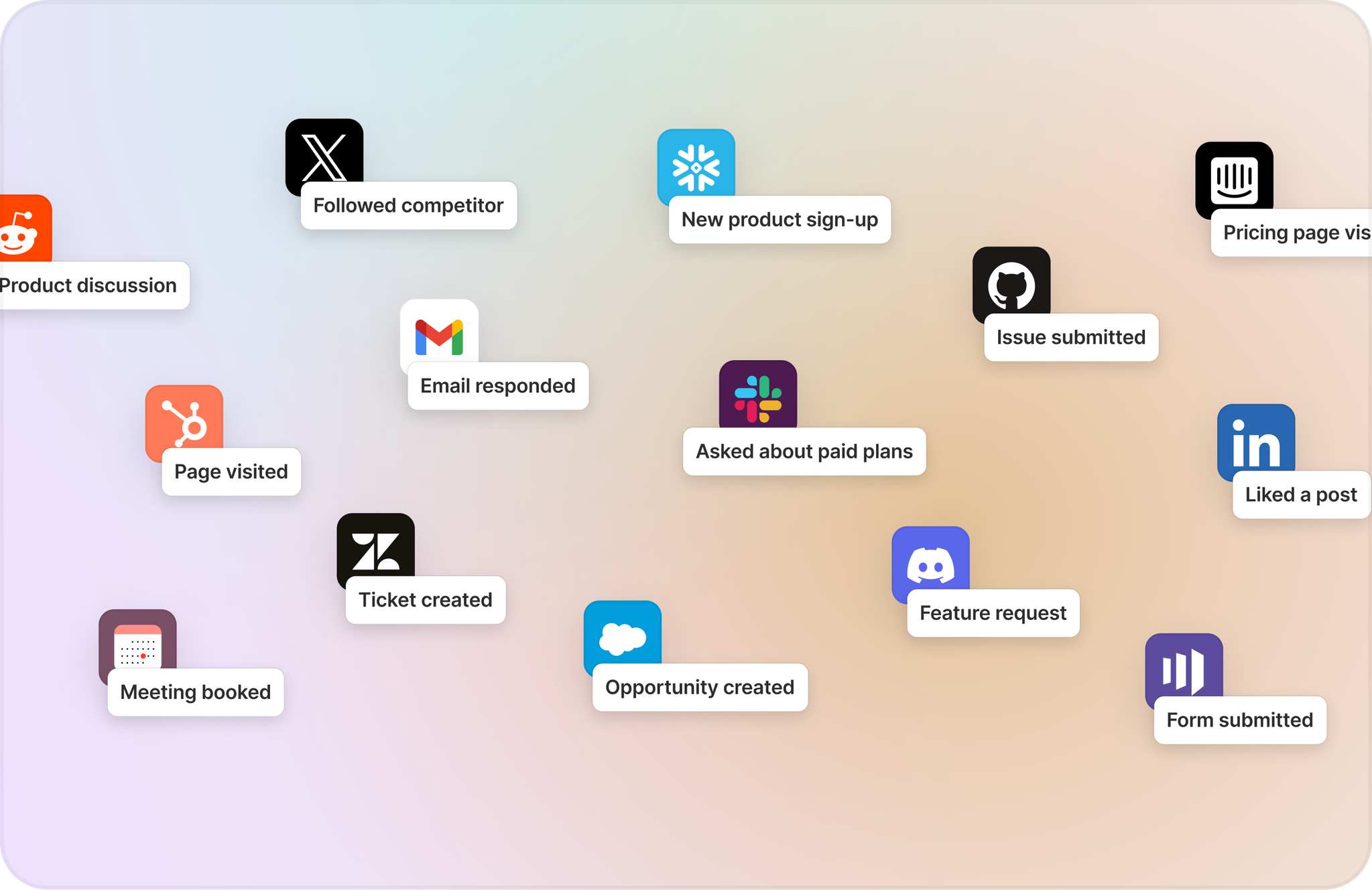
Common Room’s integrations with dozens of data sources—including popular digital channels, CRMs, data warehouses, sales execution platforms, and more—allow you to organize and access all your data in one place. This makes it easy to take action on buying signals fast.
Our AI-powered identity resolution and waterfall enrichment engine—Person360™—unifies every signal into a complete profile for contacts and organizations and fills in the blanks: job titles, work histories, contact information, company size, annual revenue, and so on.
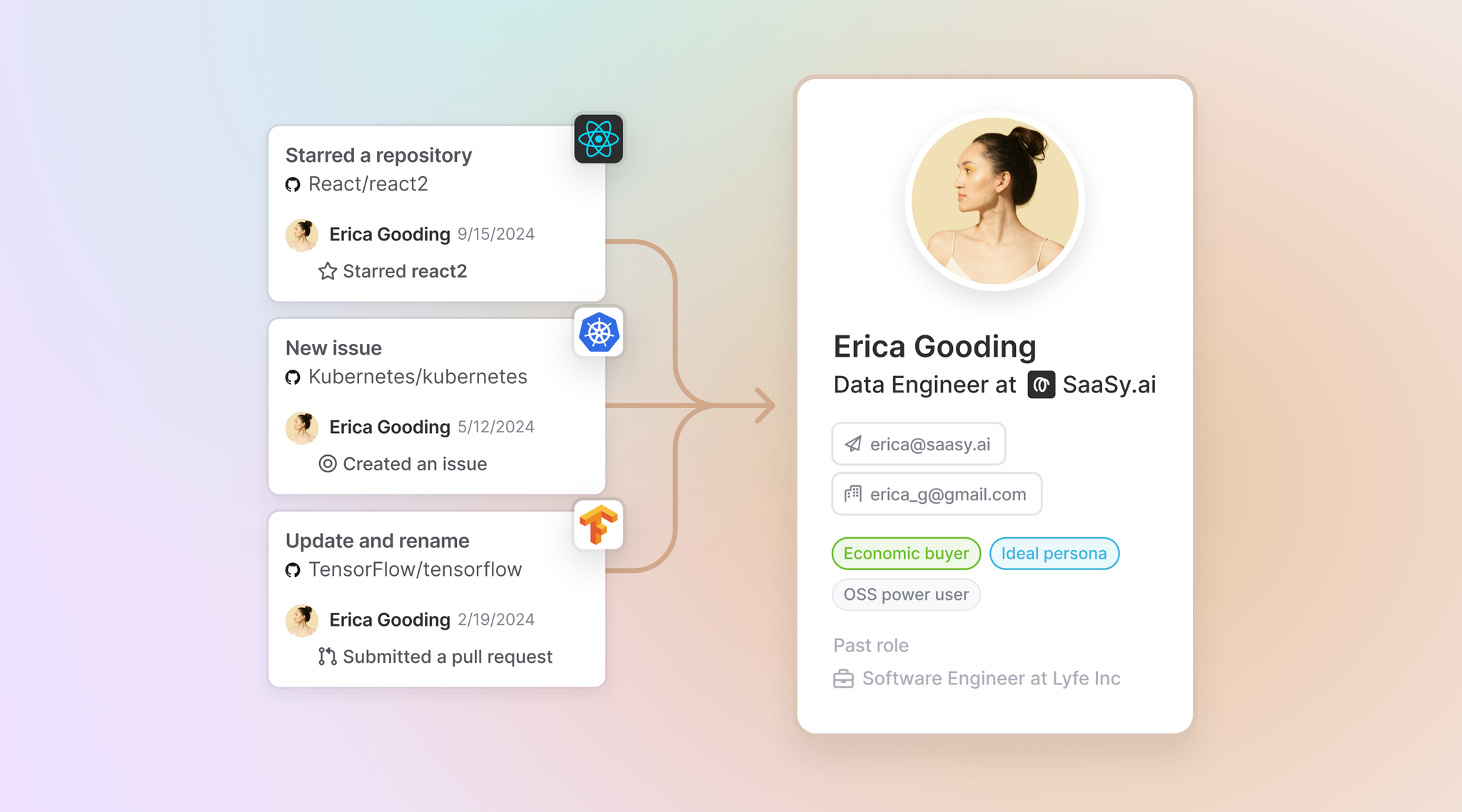
Common Room’s Person360 feature allows you to deanonymize, merge, and enrich signals from every channel connected to Common Room. This makes it easy to reveal the identity, intent, and context of every buyer and customer.
Go-to-market teams get full visibility into their open-source ecosystems. And with self-serve GitHub listening, they get visibility into alternative ecosystems, too.
Our customers track GitHub activities like pull requests, commits, forks, discussions, issues, stars, and more across alternative GitHub repos to shed more light on their target audiences and zero in on accounts that may be interested in their paid offering.
Strategy
Temporal uses automated signal capture and Person360 to aggregate signals in one place and connect people and orgs to cross-channel activities.
With person- and account-level visibility across dev watering holes, sales reps can separate hobbyists from business users and formulate the best ways to deliver value.
Meanwhile, GitHub listening allows reps to paint a fuller picture of ideal customers and better understand their wants and needs.
“Common Room's GitHub listening is one of our secret weapons at Temporal—it gives us tons of insights we wouldn't have otherwise,” said Vice President of Sales Tim Hughes. “Monitoring alternative repos helps us shine a light on new opportunities and get a better understanding of what’s top of mind for our target audience.”
Results
Centralizing cross-channel activities and revealing the people and orgs behind them helped Temporal generate more than 50% of meetings booked.
"Common Room gives our go-to-market team members daily feeds of users showing intent across multiple channels—all in one place,” Tim said. “Over 50% of our meetings come from Common Room."
Pinpoint in-market accounts
Problem
Not every open-source signal is an enterprise opportunity.
Figuring out which users are really on the hunt for a premium solution—and whether they’re the right fit—is often a guessing game.
Solution
Our customers use a combination of filters and tags to hone in on high-fit, high-intent accounts.
Contacts and orgs are filtered based on different actions and attributes—like role, location, capital raised, tech stack configuration, and more—to surface the ones reps are interested in.
FiltersCommon Room’s filters feature allows you to highlight individuals and organizations based on any combination of factors. This makes it easy to surface specific people and companies based on firmographic details, cross-channel activities, product usage, and more.
Meanwhile, with the flip of a switch, teams can automatically tag economic buyers, OSS-qualified leads, companies that match their ideal customer profile, and more for easy identification.

Common Room’s tags feature allows you to automatically label individuals and organizations with specific tags based on customizable criteria. This makes it easy to quickly filter for ideal personas, ideal customer profiles, and more.
The ability to quickly slice and dice data and spotlight ideal personas makes it easy to focus on the right accounts, such as by surfacing instances where multiple people from the same org have engaged with a repo or spotlighting orgs with open job listings that mention a relevant technology.
It’s also the basis of Common Room’s signal-based scoring, which automatically highlights the best potential leads based on customizable criteria and provides context for why different people and accounts received a certain score.
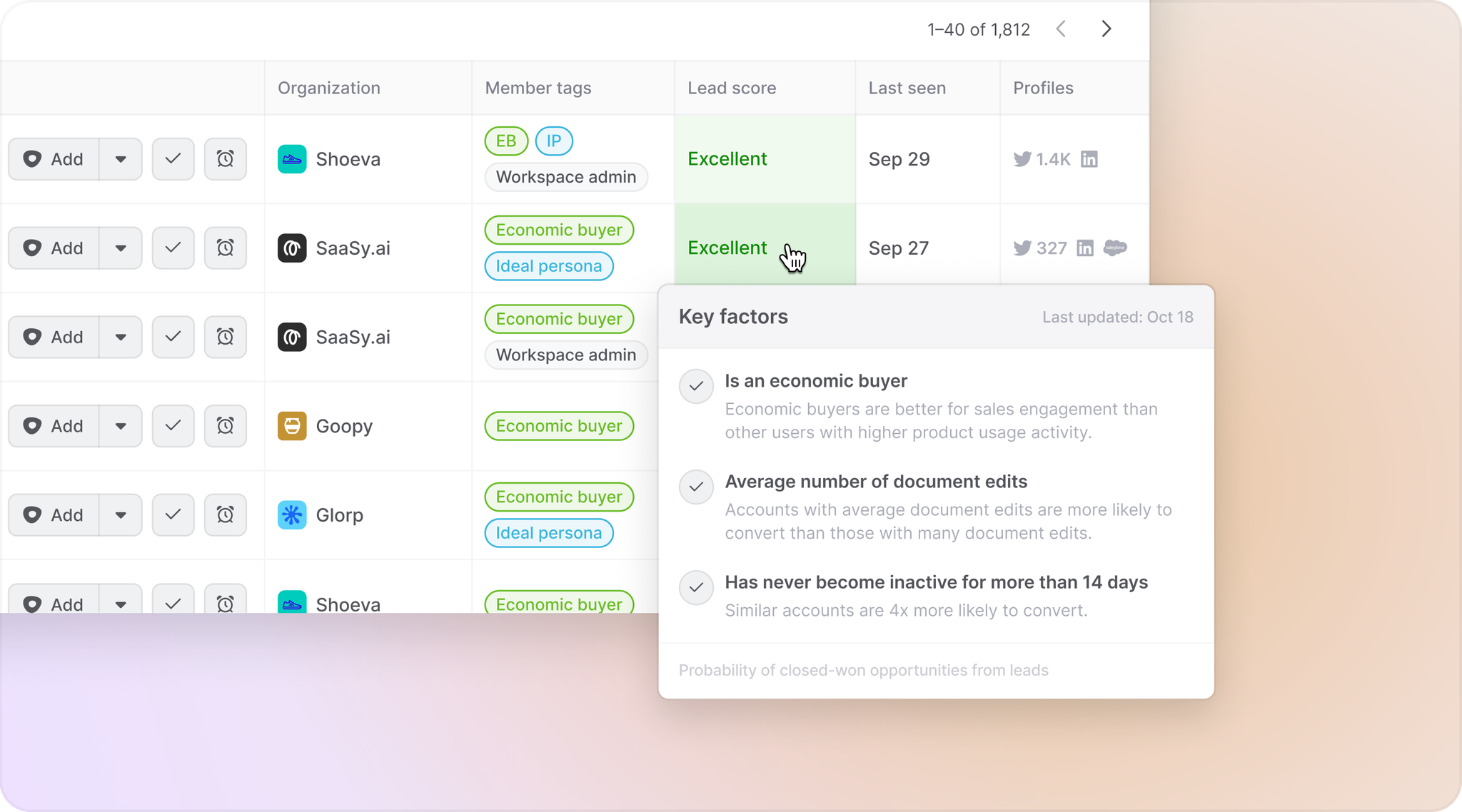
Common Room’s lead and account scoring feature allows you to instantly evaluate all opportunities based on customizable fit and behavior criteria. This makes it easy to find and follow up on the best opportunities fast using every available signal.
Our customers also use calculated fields to stack rank accounts based on the volume of whatever signals matter most to them and their business motions, like the number of engineers on staff or the number of open roles with Kubernetes as a skill requirement.
Strategy
Apollo GraphQL uses filters and tags to spotlight accounts that match the behaviors and characteristics of previous closed-won deals.
“Every customer’s journey is different,” said GTM Program Manager Aisha Nins. “No sale is exactly the same, but with all these signals embedded in Common Room, we can identify trends across the board to understand what an ideal customer looks like and where there are opportunities to engage.”
Reps get alerted in real time when individuals from ICP-match accounts take certain actions, like submitting a pull request or checking out educational content on its website.
Common Room gives them a bird’s eye view of key account info with a click—like historical engagement activity, geographic location, and industry—so they can follow up fast with full context.
Results
Making it easy for reps to find lookalike accounts and reach out with relevance helped Apollo GraphQL drive 26% of qualified leads.
“I love Common Room because it gives us visibility into so many different signals at one time to identify trends,” Aisha said. “We can see what the companies we booked meetings with have in common and we can find other companies that share those same characteristics.”
Spot above-the-line buyers
Problem
Frontline devs aren’t usually decision-makers.
Finding the right stakeholders to outreach—and crafting a compelling message—requires a lot of manual, time-consuming research.
Solution
Our customers use Prospector to find the right people to talk to at every company, even if those individuals aren’t active in their open-source ecosystem.
Teams can explore contacts at any organization, filter them based on custom criteria (including job title, job-change history, and even LinkedIn follower count), and add them to Common Room with the press of a button.
Person360 then works its magic to reveal demographic and firmographic details, as well as email addresses, phone numbers, and social handles.
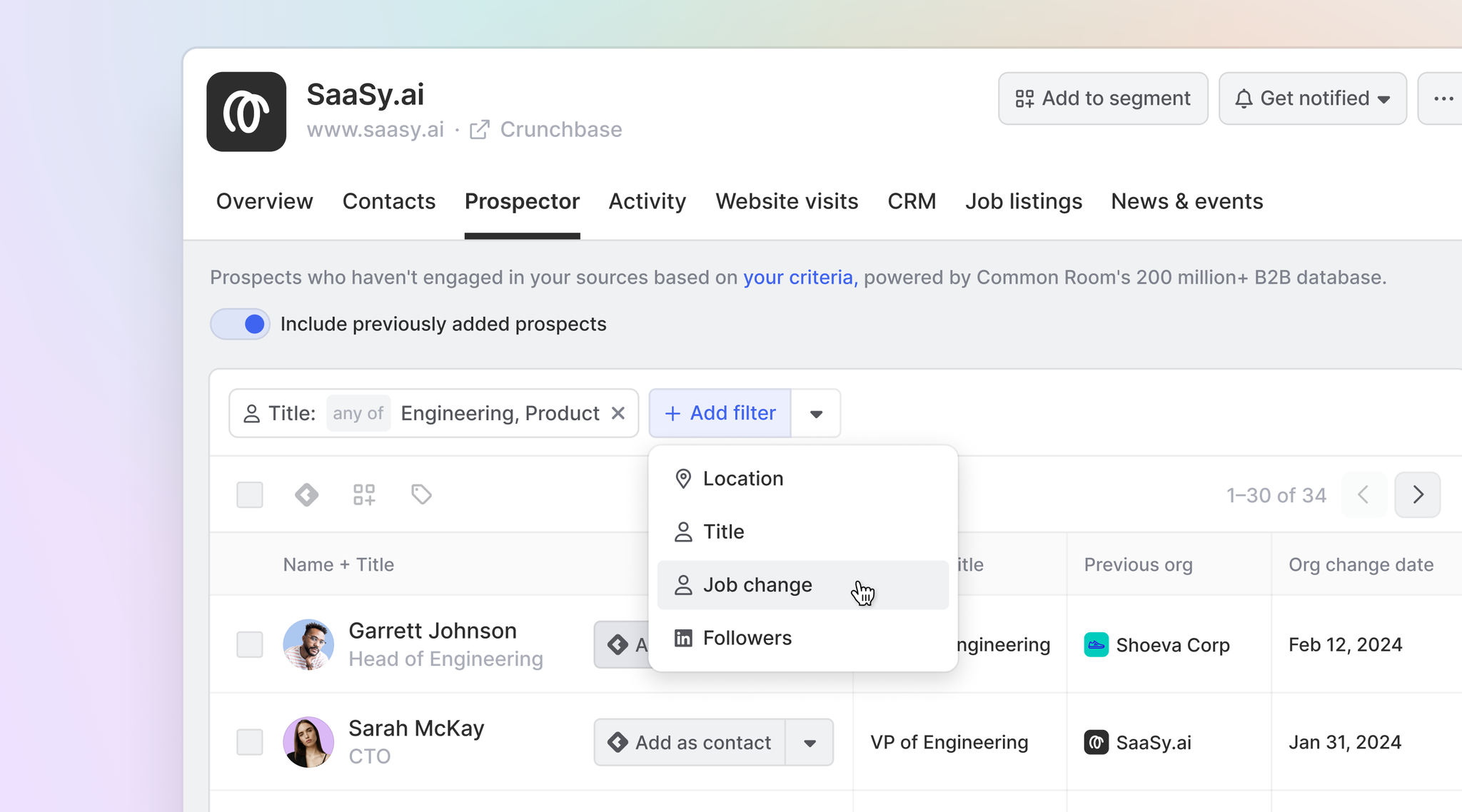
Common Room’s Prospector feature allows you to search through a proprietary, constantly refreshed database of more than 200 million B2B contacts and organizations, surface prospects and companies based on custom criteria, and automatically add individuals as contacts—even if they’re not currently engaging with your organization on any connected channels or tracked in your CRM.
Many of our customers automate this process completely.
Using Common Room’s workflow builder, they create automations that spotlight individuals at companies based on preset criteria and add them to dedicated segments.
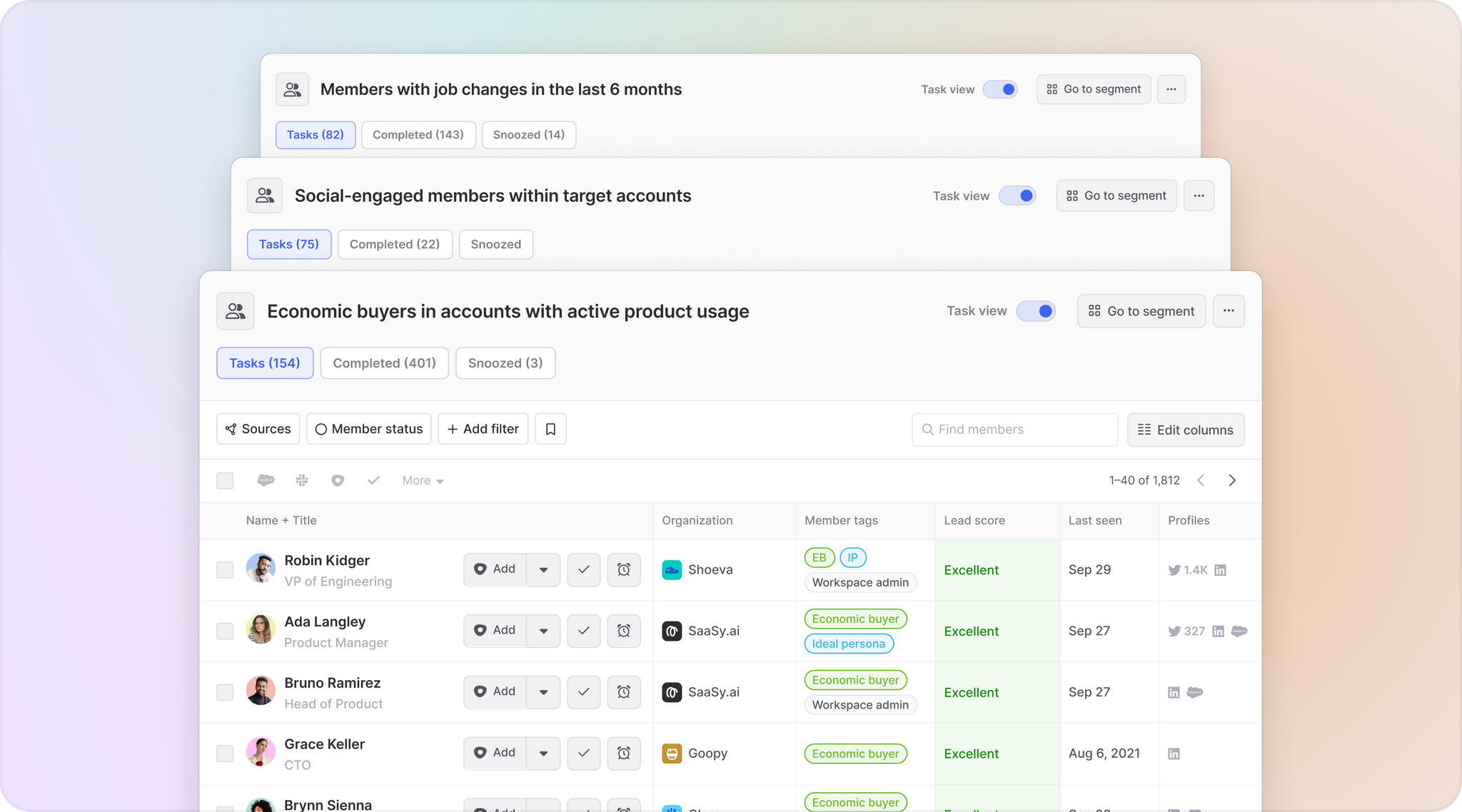
Common Room’s segments feature allows you to automatically add individuals or organizations to auto-replenishing lists based on customizable criteria. This makes it easy to quickly surface, monitor, and engage specific people and companies at scale.
From here, reps can take action—such as sending a Slack DM or adding contacts to a personalized outbound sequence—directly from Common Room. Or they can automate this process, too.
This makes it easy for reps to identify groundsell activity at high-fit accounts, spotlight budgetholders, and put signal-based prospecting on autopilot.
Strategy
Pulumi uses segments to organize, research, and engage accounts.
“The main use case right now is account research and discovering new people who are in our target accounts,” said Director of Sales Development Tyler Hayden. “The other use case is surfacing new leads to go work through Common Room. Both use cases are running, and both are booking meetings.”
Contacts and orgs are automatically added to dedicated segments based on cross-channel activities and company size.
From here, reps determine which stakeholders to reach out to and start multithreading with messaging based on the activity and firmographic info captured in Common Room.
Results
Speeding up account research and outreach helped Pulumi generate 27% of meetings booked.
“Most of the meetings being set in our open-source sales motion are sourced from signals found in Common Room,” Tyler said.
Shed light on cross-channel activity, separate real opportunities from the rest, and set sights on purchase decision-makers.
That’s how Common Room customers fuel revenue growth with open-source signals.
Open up open-source opportunities with Common Room
Get started for free or get in touch to see how Common Room’s AI-powered customer intelligence platform helps you capture, enrich, and take action on every buying signal.

